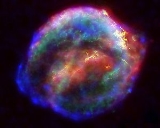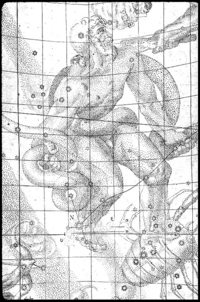
SN 1604
Encyclopedia
Supernova 1604, also known as Kepler's Supernova, Kepler's Nova or Kepler's Star, was a supernova
that occurred in the Milky Way
, in the constellation Ophiuchus
. , it is the last supernova to have been unquestionably observed in our own galaxy
, occurring no farther than 6 kiloparsecs
or about 20,000 light-year
s from Earth
. Visible to the naked eye
, it was brighter at its peak than any other star
in the night sky
, and all the planets (other than Venus
), with apparent magnitude
−2.5. It was visible during the day for over three weeks.
The supernova was first observed in northern Italy on October 9, 1604. Johannes Kepler
began observing it on October 17. It was subsequently named after him because of his book on the subject entitled De Stella nova in pede Serpentarii ("On the new star in Ophiuchus's foot", Prague 1606).
It was the second supernova to be observed in a generation (after SN 1572
seen by Tycho Brahe
in Cassiopeia
). No further supernovae have since been observed with certainty in the Milky Way, though many others outside our galaxy have been seen.
The supernova remnant
resulting from this supernova is considered to be one of the "prototypical" objects of its kind, and is still an object of much study in astronomy
.
Supernova
A supernova is a stellar explosion that is more energetic than a nova. It is pronounced with the plural supernovae or supernovas. Supernovae are extremely luminous and cause a burst of radiation that often briefly outshines an entire galaxy, before fading from view over several weeks or months...
that occurred in the Milky Way
Milky Way
The Milky Way is the galaxy that contains the Solar System. This name derives from its appearance as a dim un-resolved "milky" glowing band arching across the night sky...
, in the constellation Ophiuchus
Ophiuchus
Ophiuchus is a large constellation located around the celestial equator. Its name is from the Greek "serpent-bearer", and it is commonly represented as a man grasping the snake that is represented by the constellation Serpens. Ophiuchus was one of the 48 constellations listed by the 2nd-century...
. , it is the last supernova to have been unquestionably observed in our own galaxy
Galaxy
A galaxy is a massive, gravitationally bound system that consists of stars and stellar remnants, an interstellar medium of gas and dust, and an important but poorly understood component tentatively dubbed dark matter. The word galaxy is derived from the Greek galaxias , literally "milky", a...
, occurring no farther than 6 kiloparsecs
Parsec
The parsec is a unit of length used in astronomy. It is about 3.26 light-years, or just under 31 trillion kilometres ....
or about 20,000 light-year
Light-year
A light-year, also light year or lightyear is a unit of length, equal to just under 10 trillion kilometres...
s from Earth
Earth
Earth is the third planet from the Sun, and the densest and fifth-largest of the eight planets in the Solar System. It is also the largest of the Solar System's four terrestrial planets...
. Visible to the naked eye
Naked eye
The naked eye is a figure of speech referring to human visual perception unaided by a magnifying or light-collecting optical device, such as a telescope or microscope. Vision corrected to normal acuity using corrective lenses is considered "naked"...
, it was brighter at its peak than any other star
Star
A star is a massive, luminous sphere of plasma held together by gravity. At the end of its lifetime, a star can also contain a proportion of degenerate matter. The nearest star to Earth is the Sun, which is the source of most of the energy on Earth...
in the night sky
Night sky
The term night sky refers to the sky as seen at night. The term is usually associated with astronomy, with reference to views of celestial bodies such as stars, the Moon, and planets that become visible on a clear night after the Sun has set. Natural light sources in a night sky include moonlight,...
, and all the planets (other than Venus
Venus
Venus is the second planet from the Sun, orbiting it every 224.7 Earth days. The planet is named after Venus, the Roman goddess of love and beauty. After the Moon, it is the brightest natural object in the night sky, reaching an apparent magnitude of −4.6, bright enough to cast shadows...
), with apparent magnitude
Apparent magnitude
The apparent magnitude of a celestial body is a measure of its brightness as seen by an observer on Earth, adjusted to the value it would have in the absence of the atmosphere...
−2.5. It was visible during the day for over three weeks.
 |
The supernova was first observed in northern Italy on October 9, 1604. Johannes Kepler
Johannes Kepler
Johannes Kepler was a German mathematician, astronomer and astrologer. A key figure in the 17th century scientific revolution, he is best known for his eponymous laws of planetary motion, codified by later astronomers, based on his works Astronomia nova, Harmonices Mundi, and Epitome of Copernican...
began observing it on October 17. It was subsequently named after him because of his book on the subject entitled De Stella nova in pede Serpentarii ("On the new star in Ophiuchus's foot", Prague 1606).
It was the second supernova to be observed in a generation (after SN 1572
SN 1572
SN 1572 , "B Cassiopeiae" , or 3C 10 was a supernova of Type Ia in the constellation Cassiopeia, one of about eight supernovae visible to the naked eye in historical records...
seen by Tycho Brahe
Tycho Brahe
Tycho Brahe , born Tyge Ottesen Brahe, was a Danish nobleman known for his accurate and comprehensive astronomical and planetary observations...
in Cassiopeia
Cassiopeia (constellation)
Cassiopeia is a constellation in the northern sky, named after the vain queen Cassiopeia in Greek mythology, who boasted about her unrivalled beauty. Cassiopea was one of the 48 constellations listed by the 2nd century Greek astronomer Ptolemy, and it remains one of the 88 modern constellations today...
). No further supernovae have since been observed with certainty in the Milky Way, though many others outside our galaxy have been seen.
The supernova remnant
Supernova remnant
A supernova remnant is the structure resulting from the explosion of a star in a supernova. The supernova remnant is bounded by an expanding shock wave, and consists of ejected material expanding from the explosion, and the interstellar material it sweeps up and shocks along the way.There are two...
resulting from this supernova is considered to be one of the "prototypical" objects of its kind, and is still an object of much study in astronomy
Astronomy
Astronomy is a natural science that deals with the study of celestial objects and phenomena that originate outside the atmosphere of Earth...
.
Further reading
.- Indian Record for Kepler's Supernova: Evidence from Kashmir Valley - Article in Astronomical Notes,July2011,Vol.332,Issue 6.

